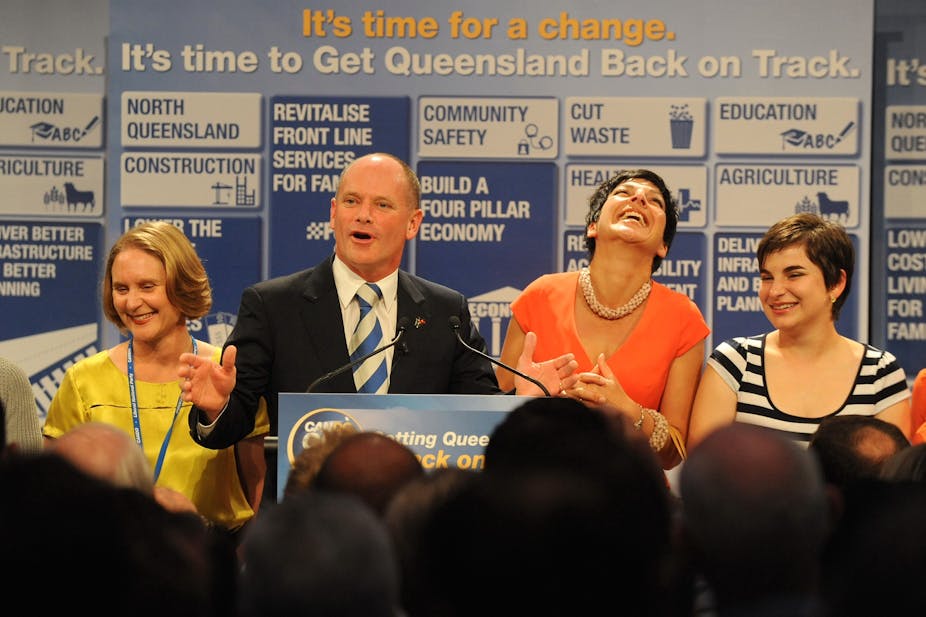The large swing to the Liberal National Party (LNP) that had been widely predicted for the Queensland state election has duly materialised at the polls on election day.
At the time of writing, late on the night of the election, the LNP is headed for a massive majority over all other parties and independent members of parliament of something in the order of 65 seats.
The only surprise on election night has been the scale of the rout, making it very likely the largest victory in Queensland – and possibly Australian – electoral history.
The swing against the Labor government, on primary votes, is in excess of 15% and current predictions suggest the party will be reduced to a single-figure number of seats, possibly as few as seven, while the LNP will go from 31 seats in the previous parliament to 77 or 78, having gained nearly 50% of the first-preference vote. Two independents will retain their seats and the recently formed Katter’s Australian Party will win two or three.
State-wide opinion polls had consistently produced a large margin in favour of the LNP over many months leading up to the election and so it proved to be. After nearly 14 years in office, the Labor government had lost its appeal to the voters, while the LNP had become revitalised under new leader, Campbell Newman, the former Lord Mayor of Brisbane. The campaign was an unusually long one, with the timing of the election signalled well in advance by the Premier, Anna Bligh.
The campaign unfolded as an intense battle between the major parties, with minor parties such as the Greens and to some extent Katter’s Australian Party, largely squeezed out amid the intensity of the two-party contest. The focus on personalities was extreme, with debate over policy issues playing very much a secondary role.
The most interesting individual contest in the election was always going to be the seat of Ashgrove, the electorate that LNP leader Campbell Newman had to win in order to enter parliament and thus become the Premier. The unique situation of the would be Premier being outside of parliament and contesting a seat that was not a foregone conclusion, saw intense interest focused on the electorate and massive resources injected into the campaigning from both major parties.
The LNP needed a 7.1% swing to win Ashgrove – as against the 4.6% swing the Party needed across the state to win government – and the Labor Party, with a popular sitting member, Kate Jones, defended the seat fiercely. Labor clearly saw its main chance of avoiding – or limiting the scale of – defeat as being to cast doubt in the minds of voters that Newman would win the seat and thereby instil some doubt about the virtues of voting the LNP into office.
In pursuing this strategy, Labor employed some harsh tactics, including personal attacks, of the kind usually agreed to be off limits by the parties, directed at the wife and other family members of Newman, in relation to business dealings.
The strategy seemed to be having an impact when opinion polls published in the weeks before polling day showed a loss by Newman to be a distinct possibility. As the election approached, however, the seat appeared to shoring up for Newman and in the end he won it easily with around twice the swing required and a majority of the first preference vote. It is possible, however, that the choice of this seat for Newman may yet prove to be problematic, since it may be vulnerable in future elections when the inevitable happens and tide starts to turn against the LNP government.
Other seats of particular interest include those of Mt Coot-tha, Brisbane Central, Greenslopes and Stafford, in Brisbane, held for Labor by Andrew Fraser, Grace Grace, Cameron Dick and Stirling Hinchliffe, respectively. All of these appear to be lost for Labor and with them the four most obvious leadership hopefuls to replace Anna Bligh. Thus, the Labor Party is not only reduced to a small number of seats, but also faces a leadership void, at least in the short-term, as it regroups and attempts to rebuild credibility within the Queensland electorate. By early in the count the public recriminations had already begun, with a number of senior Labor figures openly criticising both Bligh and the campaign strategy.
But across the state the same picture is repeated – the LNP has captured seat after seat, including some that it would never normally dream of winning, such as Ispwich, and some that Labor has never lost and has held for well over a century, such as Cairns.
The incoming government will face many policy challenges in the form of the massive state debt, oversight of the coal seam gas industry and restoring confidence in public administration, particularly in relation to health. These are but some of the issues that underpinned the campaign, but in fact received little explicit attention and debate. Queensland joins other states – most notably New South Wales – in having a long-term Labor government ejected unceremoniously by the electorate in recent years. It is a trend that does not augur well for the federal Labor government that is currently holding office by the narrowest possible margin.
Finally, the massive win for the LNP also has federal implications for the Coalition Liberal and National parties. It will give a boost to those on the non-Labor side of politics who would wish the Coalition to become a single party.

